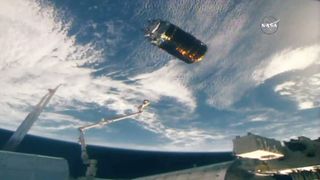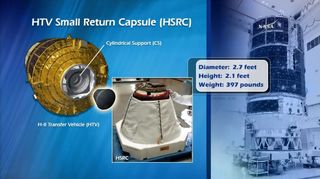Japanese Cargo Ship Departs Space Station. Next Stop: Oblivion.
A robotic Japanese cargo ship cast off from the International Space Station Wednesday (Nov. 7) for a weekend date with oblivion to wrap up a successful resupply mission.
Astronauts on the station released the HTV-7 supply ship from the station using a robotic arm at 11:51 a.m. EST (1651 GMT) as both spacecraft sailed 254 miles above the northern Pacific Ocean. The Japan Aerospace Exploration Agency (JAXA) launched the cargo ship to the station in late September to deliver more than 5 tons (4.5 metric tons) of fresh food, science gear and other supplies.
"The Expedition 57 crew would like thank the entire JAXA program and engineering teams for the flawless design and execution of the HTV-7 resupply mission," station commander Alexander Gerst of the European Space Agency radioed Mission Control after the successful undocking. The cargo ship, he added, is a vital part of a truly international effort to support the world's only outpost in space. Gerst used the robotic arm to release HTV-7 with support from NASA astronaut Serena Auñón-Chancellor. [Japan's Huge HTV Space Truck Explained (Infographic)]
JAXA's HTV cargo ships (short for H-2 Transfer Vehicles) are disposable spacecraft designed to haul tons of supplies to the space station, and then depart and intentionally burn up in Earth's atmosphere at mission's end. The spacecraft, also known as Kounotori (Japanese for "white stork") are part of a fleet of robotic cargo ships from Japan, Russia, Europe and the United States that have kept the station stocked with supplies over the last 18 years.

HTV-7 delivered some critical supplies for the International Space Station's crew, including six new batteries for the orbiting lab's solar power grid. It also carried two tiny cubesats for a space elevator experiment (which were deployed Oct. 6) and a small re-entry capsule that, in a first for Japan, will attempt to return experiments to Earth. If all goes well, the capsule will be deployed just before HTV-7 falls back to Earth over the South Pacific on Saturday (Nov. 10), NASA officials said.
Called the HTV Small Return Capsule, the cone-shaped vehicle is 2.7 feet wide (0.8 meters), 2.1 feet tall (0.6 m) and weighs 397 pounds (180 kilograms).

"The return capsule will be ejected from a hatchway after the deorbit burn," NASA officials said in a statement. "The experimental capsule will perform a parachute-assisted splashdown off the coast of Japan, where a JAXA ship will be standing by for its recovery."
Get the Space.com Newsletter
Breaking space news, the latest updates on rocket launches, skywatching events and more!
NASA officials said the capsule is carrying protein crystal growth experiment results.
Gerst wished the team behind the re-entry capsule luck in their upcoming technology test. It was he and his Expedition 57 crewmates who packed the capsule with its experiment cargo and attached it to the HTV-7 hatch.
"We congratulate all the participating engineers for the successful design and assembly of the small return capsule, and we wish all the best for the upcoming, most interesting, phase of the return capsule mission: the re-entry and descent."
Email Tariq Malik at tmalik@space.com or follow him @tariqjmalik. Follow us @Spacedotcom and Facebook. Original article on Space.com.
Join our Space Forums to keep talking space on the latest missions, night sky and more! And if you have a news tip, correction or comment, let us know at: community@space.com.

Tariq is the Editor-in-Chief of Space.com and joined the team in 2001, first as an intern and staff writer, and later as an editor. He covers human spaceflight, exploration and space science, as well as skywatching and entertainment. He became Space.com's Managing Editor in 2009 and Editor-in-Chief in 2019. Before joining Space.com, Tariq was a staff reporter for The Los Angeles Times covering education and city beats in La Habra, Fullerton and Huntington Beach. In October 2022, Tariq received the Harry Kolcum Award for excellence in space reporting from the National Space Club Florida Committee. He is also an Eagle Scout (yes, he has the Space Exploration merit badge) and went to Space Camp four times as a kid and a fifth time as an adult. He has journalism degrees from the University of Southern California and New York University. You can find Tariq at Space.com and as the co-host to the This Week In Space podcast with space historian Rod Pyle on the TWiT network. To see his latest project, you can follow Tariq on Twitter @tariqjmalik.
Most Popular


